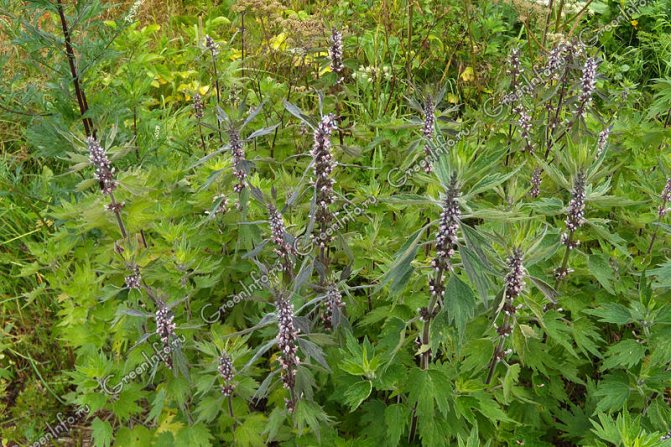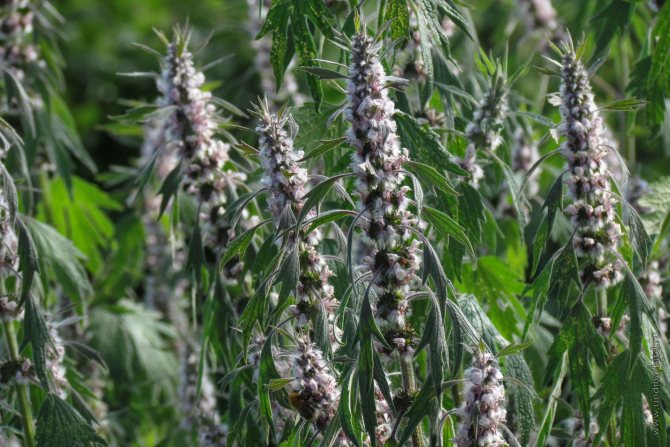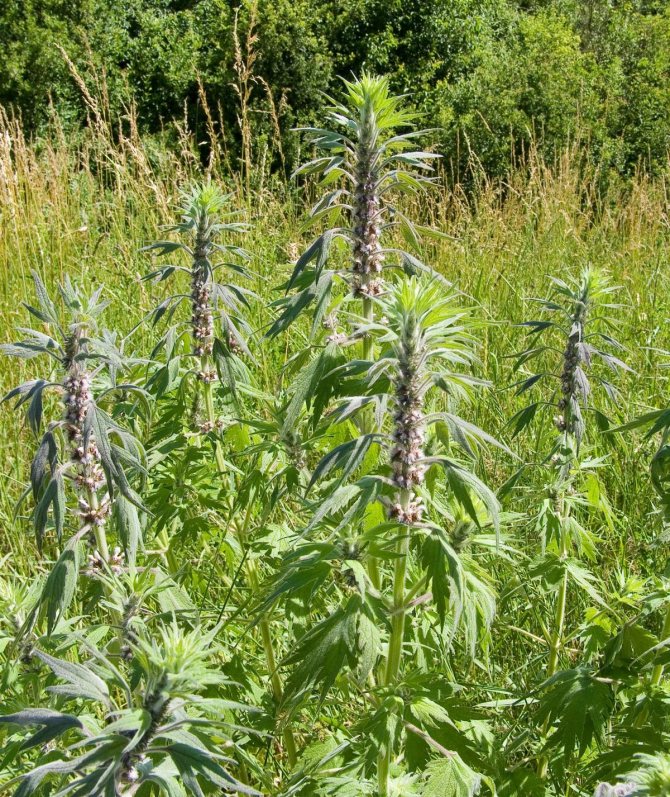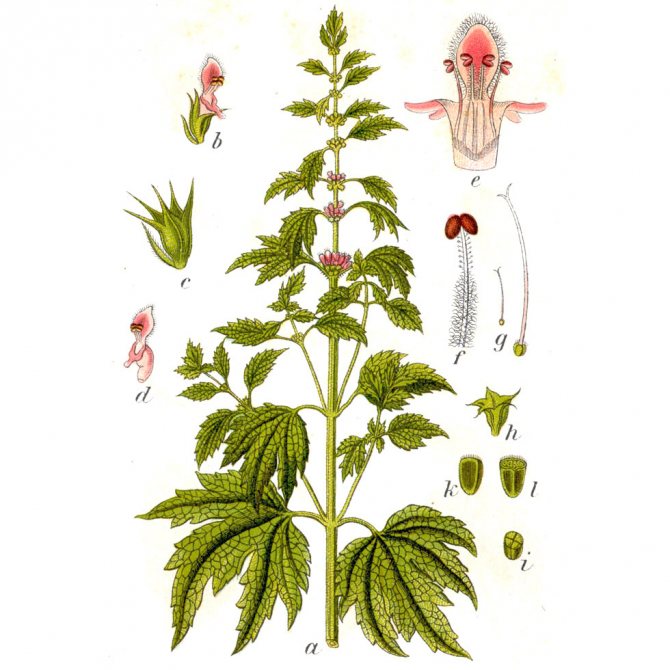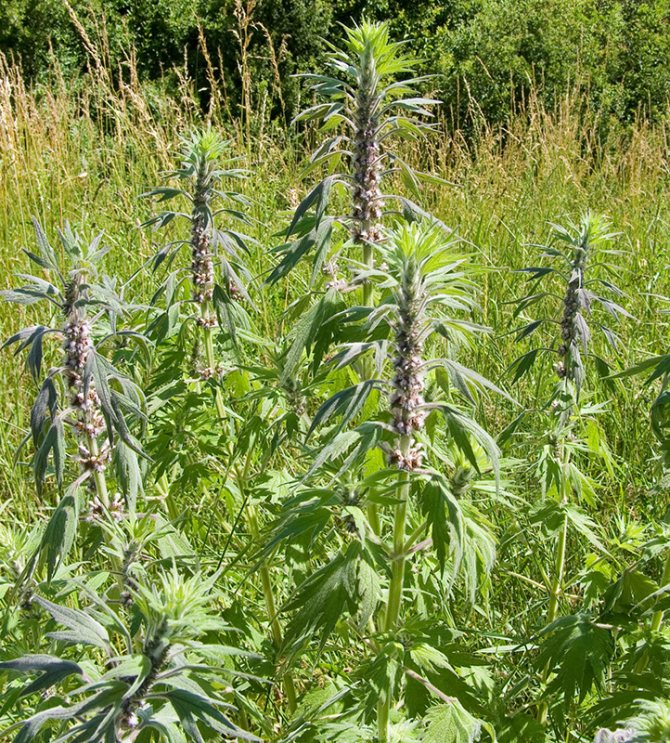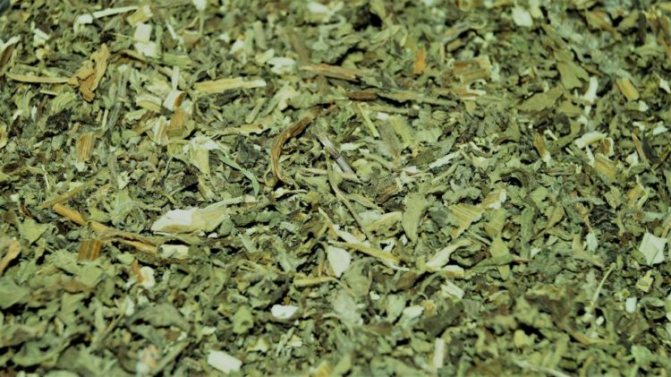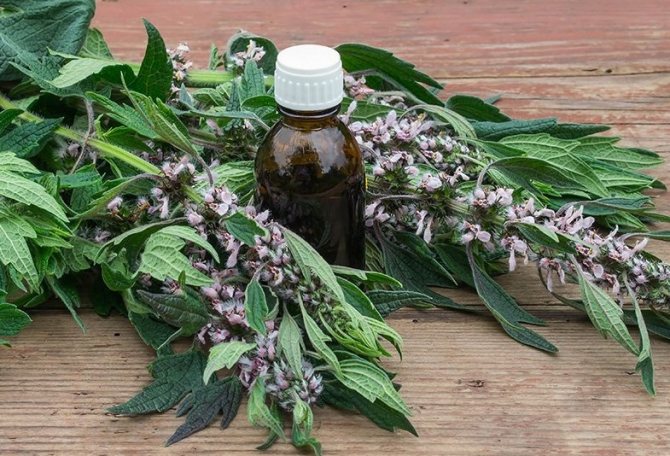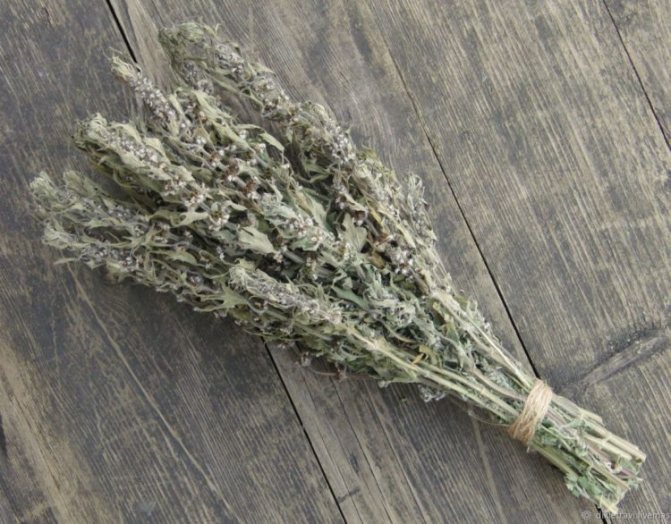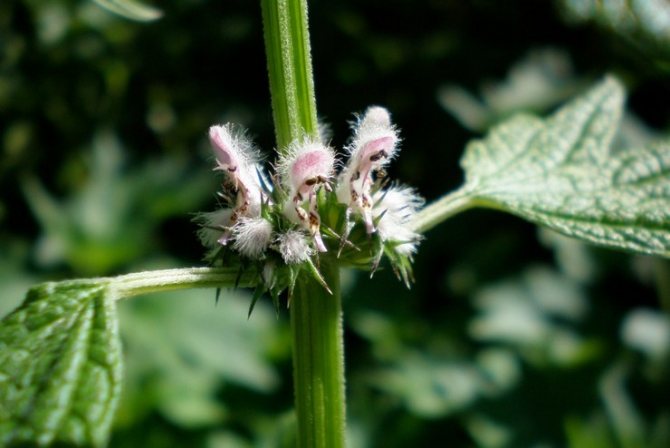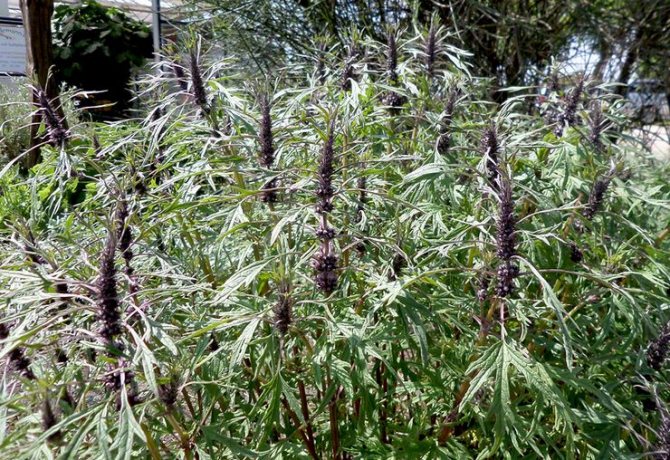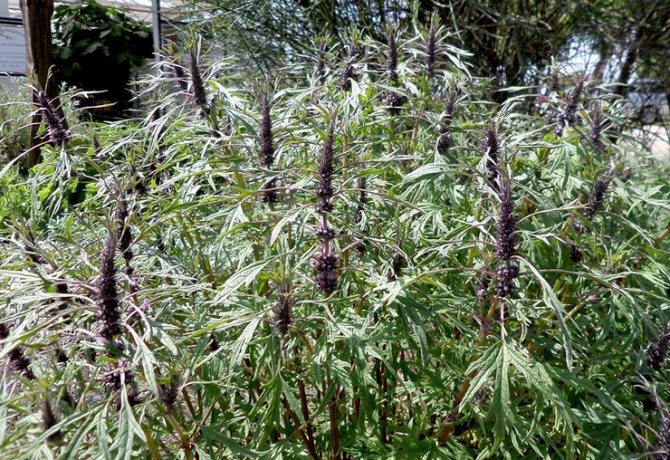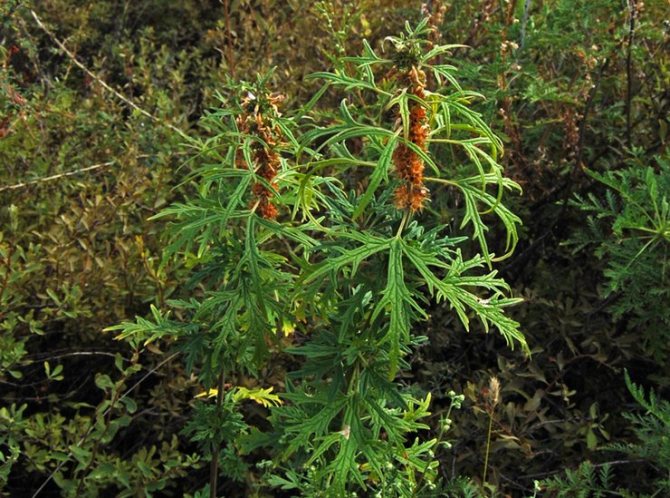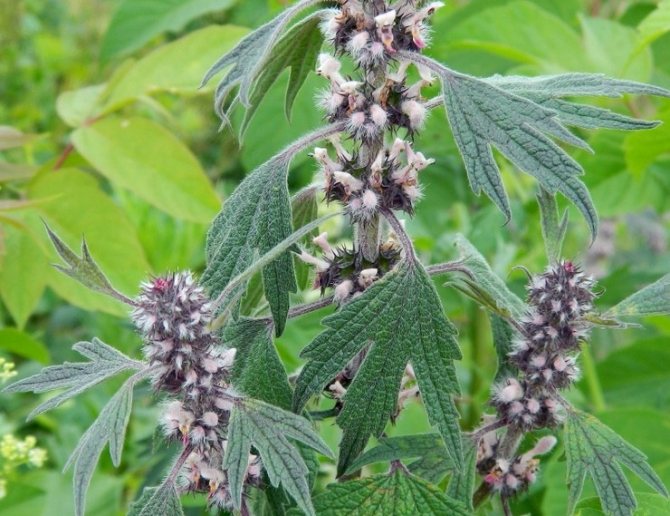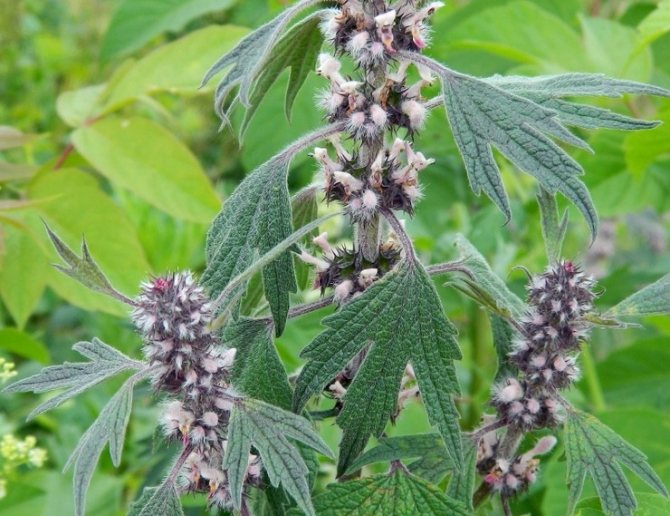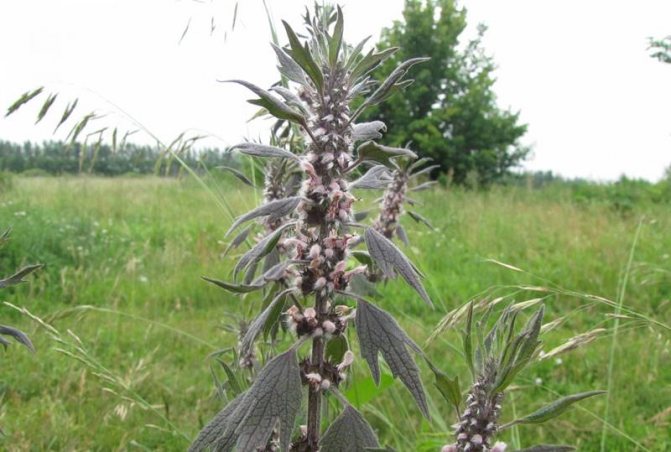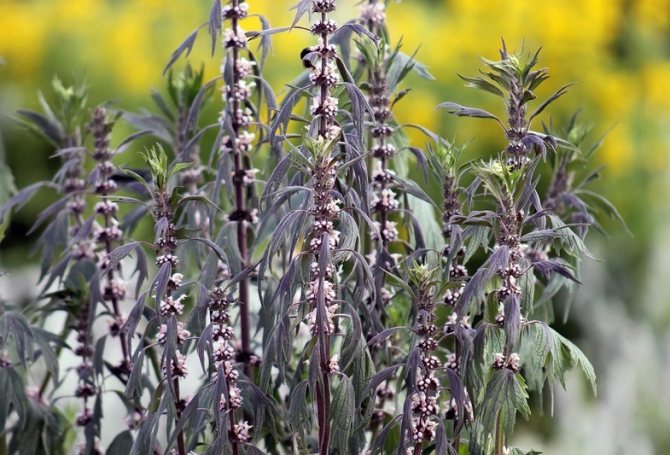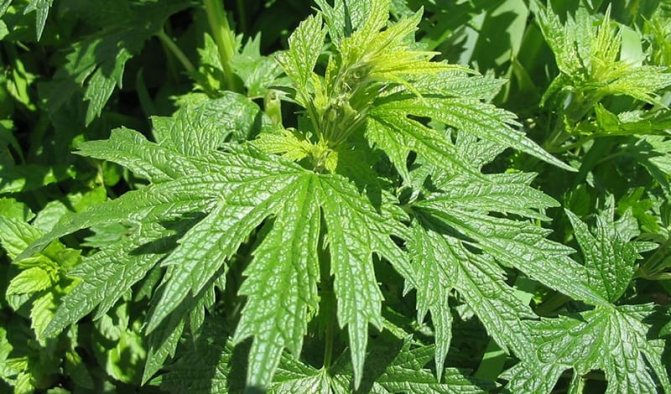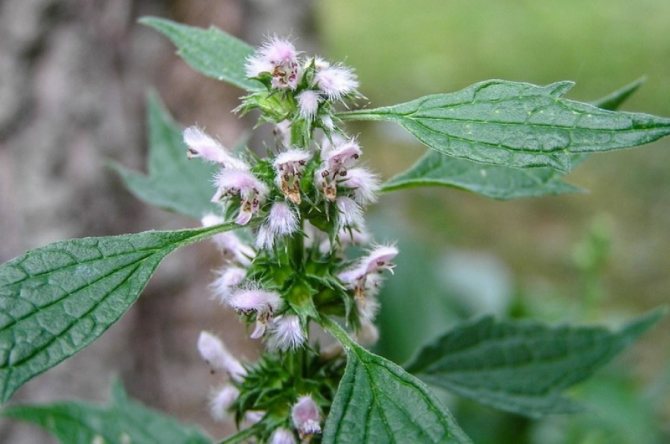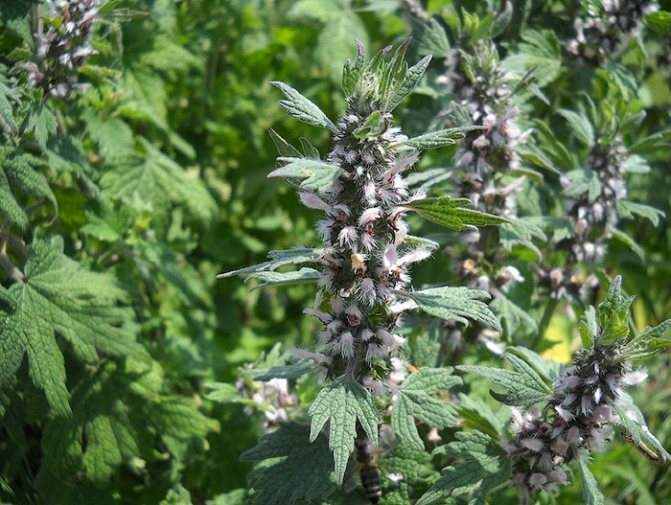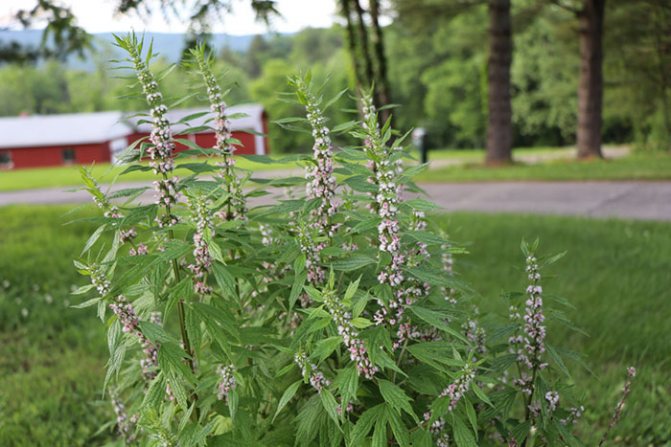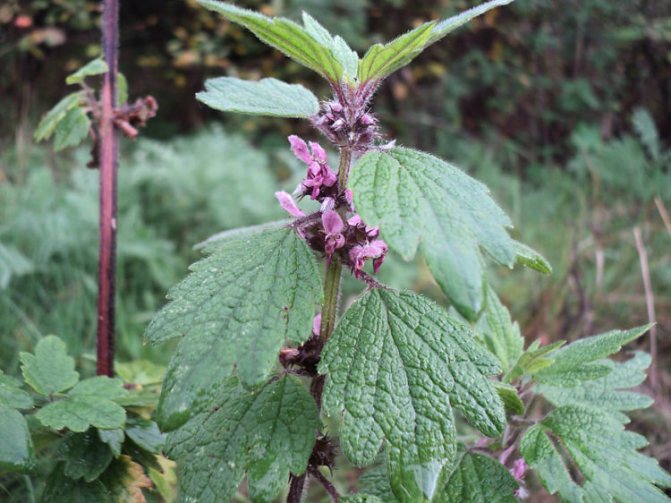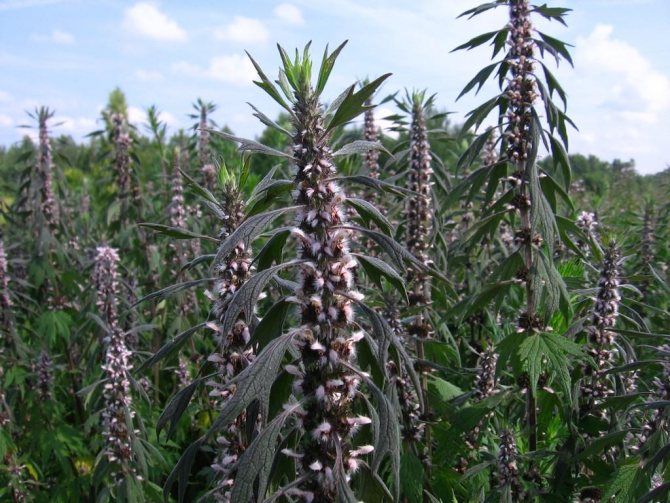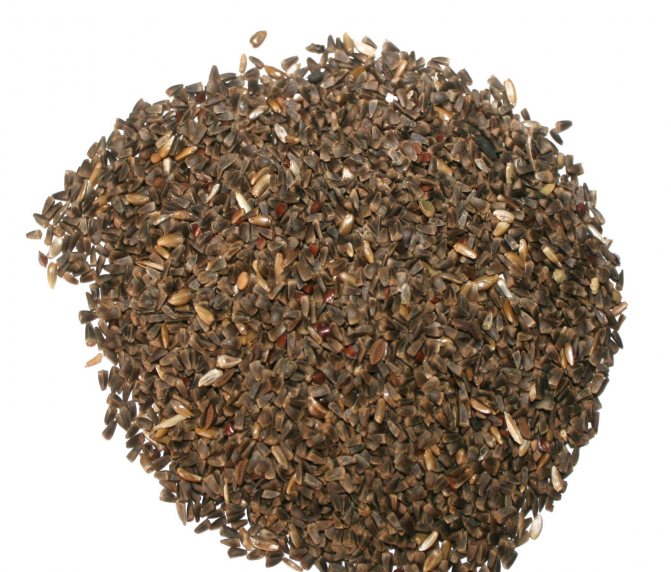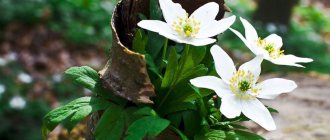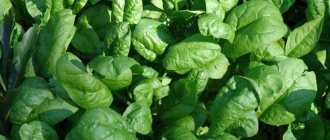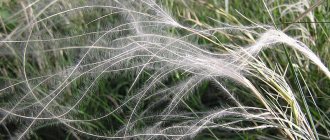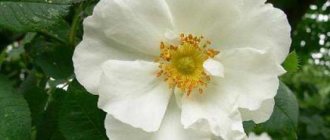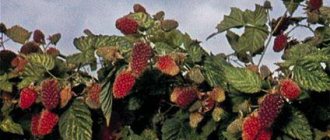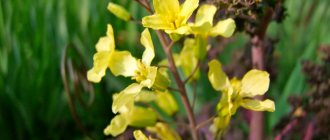Perennial herb. In traditional and folk medicine, it is valued for its bactericidal, sedative, cardiotonic, sedative, antispasmodic, hypotensive effect. Suitable for women, children and men. Most often it is used in the form of alcohol tincture and tablets.
Motherwort (Leonúrus) is a genus of biennial or perennial herbaceous plants of the Lamiaceae or Labiatae families. Eurasian genus, several species settled in North America. Some species are valuable medicinal plants.
Popularly known as:
- heart herb;
- dog nettle;
- wild nettle;
- deaf nettle;
- core.
Motherwort = green pharmacy
For a long time, motherwort has proven itself as a medicinal plant for many ailments. In nature, there are several types of it, but in medicine it is most often used motherwort heart (Leonurus cardiaca). It is a herbaceous perennial hairy plant with a woody rhizome.
RARE PLANT SEEDS FOR YOUR GARDEN - FREE SHIPPING. PRICES ARE VERY LOW. THERE ARE REVIEWS

Motherwort of the heart has pink flowers, sometimes with a purple tint. These modest, angelic, at first glance, flowers are very insidious, as they are armed with thorny bracts, which, through negligence, can hurt painfully while collecting motherwort. And it is harvested in August, just during flowering. The upper part of the plant is used as a medicinal raw material (it is better to discard the faded, rough and lower inflorescences).
Motherwort herb contains alkaloids, flavonoids, tannins, organic acids, essential oil, bitter and sugary substances, carotene. This is the reason for its therapeutic effect.
Motherwort drugs primarily have a sedative effect, and also slow down the heart rate (the effect is explained by the presence of alkaloids and flavonoids).
Botanical description
Depending on the species, motherwort grows from 30 to 200 cm. The stem is erect, tetrahedral, in some cases branched.
The leaves are petiolar, the lower ones are larger, dissected or palmate-lobed, the upper ones are whole or the same as below.
The flowers are small, intermittent, collected in spike-shaped inflorescences, located in the axils of the leaves and at the ends of the branches of the stems. Flowers have 4 stamens. Calyx hairy or glabrous, incised to the middle or 1/3 to 5 teeth. Blooms throughout the summer.
The fruit consists of 4 nut-like parts, the so-called erem. The length of each such part is 2-3 mm, enclosed in the remaining calyx. The spread of fruits occurs due to attachment to clothing or animal hair.
Views from photo
In total, there are about 25 species of motherwort. As a medicinal product, only 3 are used.
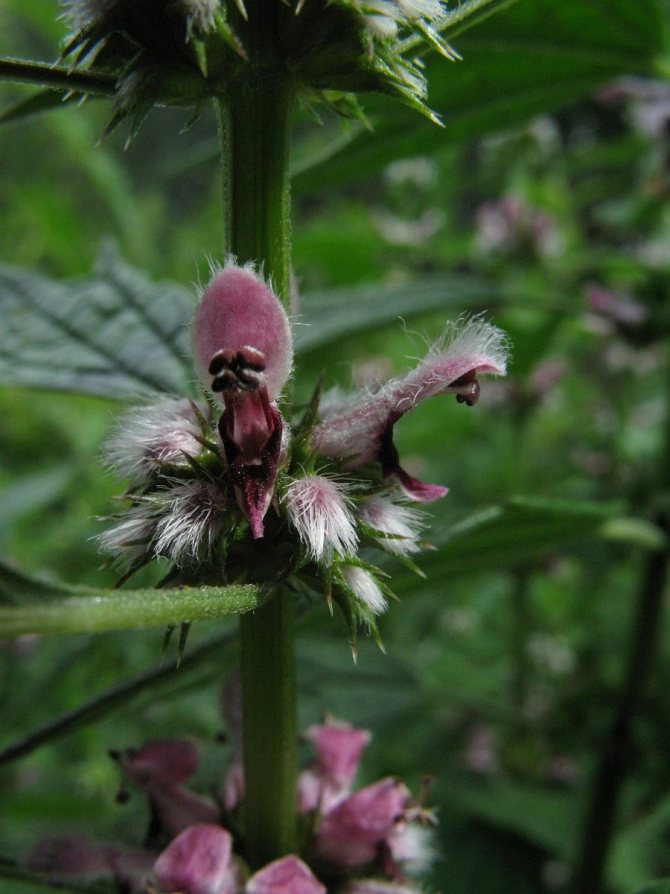

- Motherwort heartwort or common. A distinctive feature is a completely bare stem, slightly hairy on the ribs. There are also few glandular hairs on the leaves, and the flowers with a bare calyx are small. This species grows in abandoned parks, among bushes, in weedy places, near dwellings, in gardens, near fences. It is found in the Baltic States, the Black Sea region, Belarus, throughout the European territory of Russia and Western Siberia, with the exception of the Far North.
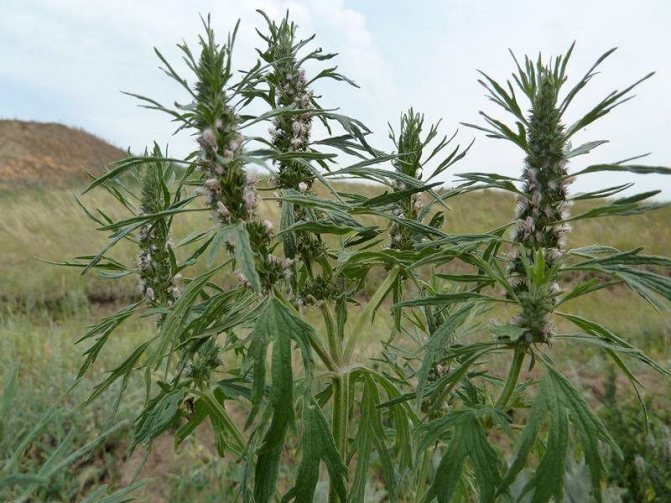

- Motherwort is gray.The name comes from the grayish-gray color of the leaves and stem. The stem reaches a height of 1 m, thinly pubescent. Flowers on whorls are small, pale pink.
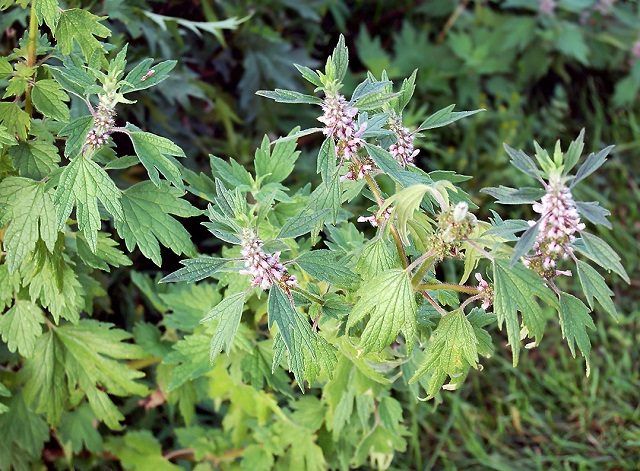

- Motherwort five-lobed or hairy. It grows in height 50 - 150 cm. The stem is pubescent with hairs, erect, with few branches. Leaves are serrated along the edge, 3-5 lobed, on both sides with leaves with glandular hairs, the upper side is dark green, the lower one is gray. The flowers are pink, small, collected in whorls, two-lipped. Occurs on sandy loam and loamy soils along forest edges, clearings in mixed and coniferous forests, on wastelands and weedy places. It is widespread in the European part of Russia, with the exception of the Far North, and is also not uncommon in Western Siberia, Ukraine, Central Asia, Belarus, and the Caucasus.
Spread
This herb is found in Siberia, Central Asia, Europe, and the Middle East. The core grows in meadows, wastelands, glades, along river banks, in ravines and old quarries, railway embankments. Prefers clay-sandy soil. In the European part of the planet, the heartwort is widespread, in Russia - the five-lobed.
Collection and procurement
Leaves and the entire apical part together with flowers are harvested from motherwort, therefore it is better to collect during the flowering period, when the flowers are fully open. The best time for this is July. Harvesting must be done in clear and dry weather. The cut grass is laid out in a thin layer. Dry preferably indoors without exposure to sunlight, but with air access. During the process, the core needs to be agitated frequently. The fragility and fragility of the raw material indicates its readiness. Then it should be placed in linen bags or wooden boxes, where the product will be protected from moisture. Shelf life is no more than 3 years.
Motherwort - application
It is used in the form of a tincture of 30-40 drops, a liquid extract - 15-20 drops each and an infusion of 15 g of raw materials per 200 ml of water - 1 tbsp. spoon 3-4 times a day with cardiac neuroses and increased nervous excitability.
Motherwort will also help in the initial stages of hypertension.
Curious facts about the application of the properties of motherwort
- Russian folk medicine advises taking motherwort to treat persistent cough.
- German - uses motherwort for palpitations, asthma, headache, anemia, painful menstruation.
- Romanian doctors recommend treating Graves' disease and epilepsy.
- The British use this herb as a cure for hysteria, shortness of breath, heart weakness.
- In India, motherwort is considered not only a cardiac but also a gastric remedy.
- In the US, it replaces valerian.
Reference by topic: Bitter wormwood - medicinal properties and application
Contraindications and side effects
Pregnant women should refrain from taking medications based on motherwort, as this can lead to uterine contraction and bleeding. It is also not recommended for people with individual intolerance. Use herb with caution in case of hypotension, as it has the ability to reduce blood pressure and can cause lethargy and drowsiness.
In case of an overdose, attacks of vomiting, dry mouth, stools with blood impurities, painful sensations in the muscles and joints are often observed. In order to avoid unpleasant consequences, it is necessary not to abuse the funds based on the core and be sure to consult a specialist before taking it.
Motherwort bath
Medicinal baths from motherwort herb have a good healing and restorative effect on the nervous system (the duration of such a bath is 20-25 minutes). They can include an infusion, decoction or liquid extract of one motherwort, as well as mixtures of motherwort with other medicinal plants.To restore strength, with chronic fatigue, an excited state of the nervous system, increased irritability (including in menopause), it is recommended to take baths from motherwort herb in combination with mint, yarrow, calamus root. Such baths have a tonic effect, improve overall health and mood.
Doctors and folk healers advise taking short-term motherwort baths to people suffering from high blood pressure, chronic headaches, heart rhythm disturbances, narrowing of the coronary vessels, persistent sleep disorders.
Thanks to the effects of alkaloids and essential oil, with the regular intake of such baths, a sick person, if not completely cured of an ailment, then at least significantly alleviates his condition.
Motherwort can also be used as a soothing agent in baths for young children.
The broth for these purposes is prepared as follows: 3-4 tbsp. tablespoons of dry chopped herbs, you must pour 1 liter of boiled water. Insist a little, strain and add a little to the bath where the baby is bathing.
Chemical composition and medicinal properties
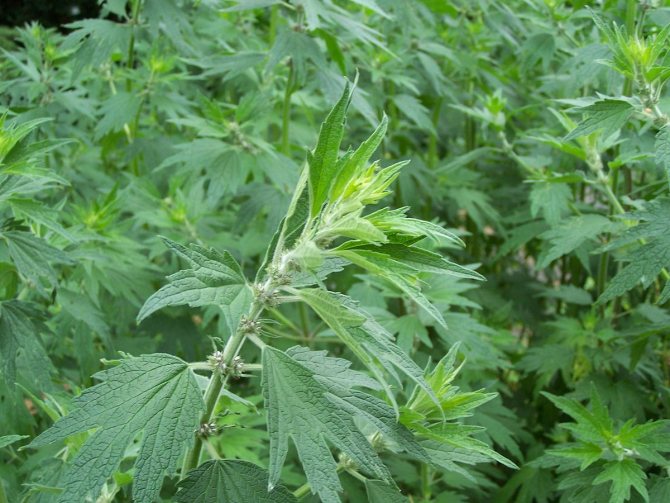

The main active ingredients of motherwort herb are:
- Flavonoids;
- Alkaloids;
- iridoids.
Also contains a large amount:
- vitamins (choline, beta-carotene, vitamins B, C);
- quercetin;
- tannins;
- saponins;
- diterpenoids;
- steroid glycosides;
- essential oil;
- acids (malic, oleic, citric);
- tannin;
- alkanoids;
- bitter substances;
- terpenoids.
With the above substances, the heart herb is characterized by:
- laxatives;
- antispasmodic;
- antineoplastic;
- calming;
- choleretic;
- immunostimulating;
- anticonvulsants;
- antimicrobial properties.
Motherwort is an excellent honey plant
Motherwort honey is very beneficial for health. And you can also rub it into the hair roots 20 minutes before washing - hair becomes fluffy, and their growth increases.
As you can see, many miracles, mysteries, discoveries are fraught with a modest, unpretentious medicinal plant, which, perhaps, grows in a wasteland nearby.
<ольга>
ORDER QUALITY AND CHEAP SEEDS AND OTHER PRODUCTS FOR HOME AND COTTAGE. PRICES ARE BOTTLE. CHECKED! JUST LOOK FOR YOURSELF AND BE AMAZED HOW WE HAVE REVIEWS. GO >>>
Below are other entries on the topic "Cottage and garden - do it yourself"
- Growing medicinal herbs in the garden and on the site: How to grow medicinal herbs directly ...
- Woodlice weed (starlet) - benefits and properties: Woodlice grass - to whom weed, ...
- Preparation of herbal tea balsams. Useful properties and treatment .: How to prepare medicinal tea balsams Often ...
- Galega goat's rue planting and useful properties: Galega plant - growing and ...
- Useful properties of an ordinary mother-and-stepmother about which few people know: MOTHER-AND-STEPMOM FOR Losing weight AND NOT ...
- How to sow a lawn into "bald patches": Correct sowing of a lawn with your own hands Decorative ...
- Plants for Lowering Blood Cholesterol: How to Lower Cholesterol in ...
Subscribe to updates in our groups and share.
TESTS
Humidity
Whole raw materials, crushed raw materials, powder - no more than 13%.
Ash total
Whole raw materials, crushed raw materials, powder - no more than 12%.
Ash insoluble in hydrochloric acid
Whole raw materials, crushed raw materials, powder — no more than 6%.
Grinding of raw materials
Whole raw materials: particles passing through a sieve with holes of 3 mm - no more than 5%. Crushed raw materials: particles that do not pass through a sieve with openings of 7 mm - no more than 5%; particles passing through a sieve with holes of 0.18 mm - no more than 5%.Powder: particles that do not pass through a sieve with holes of 2 mm - no more than 5%; particles passing through a sieve with holes of 0.18 mm - no more than 5%.
Impurities
Raw materials that have discolored (darkened and blackened). Whole raw materials, shredded raw materials — no more than 7%.
Stems. Whole raw materials - no more than 46%.
Pieces of stems. Shredded raw materials — no more than 46%.
Organic impurity. Whole raw materials, shredded raw materials — no more than 3%.
Mineral admixture. Whole raw materials, crushed raw materials, powder — no more than 1%.
Heavy metals
The determination is carried out according to the General Pharmacopoeia Monograph "Determination of the content of heavy metals and arsenic in medicinal plant raw materials and medicinal herbal preparations."
Radioactivity
The determination is carried out according to the General Pharmacopoeia Monograph "Determination of the content of radionuclides in medicinal plant raw materials and medicinal herbal preparations".
Residual amounts of pesticides
The determination is carried out in accordance with the requirements of the General Pharmacopoeia Monograph "Determination of the content of residual pesticides in medicinal plant raw materials and medicinal herbal preparations".
Microbiological purity
The determination is carried out according to the General Pharmacopoeia Monograph "Microbiological purity".
quantitation
Whole raw materials, crushed raw materials, powder: the sum of flavonoids in terms of rutin - not less than 0.2%; extractives extracted with 70% alcohol - not less than 15%.
The amount of flavonoids
An analytical sample of the raw material is crushed to the size of particles passing through a sieve with holes of 0.5 mm. About 2.5 g (accurately weighed) of the crushed raw material is placed in a conical flask with a capacity of 250 ml, 50 ml of 70% alcohol is added, the flask is closed with a stopper, weighed with an error of + 0.01 g and left for 1 hour. Then the flask is connected to a reflux condenser , heated in a water bath, maintaining a weak boil for 1 hour. Then the flask is cooled to room temperature, weighed, if necessary, bring its contents to the initial mass with 70% alcohol. The contents of the flask are filtered through a folded paper filter, discarding the first 25 ml of filtrate (solution A).
Place 2.0 ml of solution A in a 25 ml volumetric flask, add 5 ml of aluminum chloride in an alcohol solution of 2% and bring the volume of the solution to the mark with 96% alcohol, mix (solution B). After 30 min, the optical density of solution B is measured on a spectrophotometer at a wavelength of 410 nm in a cuvette with a layer thickness of 10 mm.
As a reference solution, a solution consisting of 2.0 ml of solution A, 0.1 ml of glacial acetic acid brought up to the mark with 96% alcohol to the mark in a 25 ml volumetric flask is used.
The content of the sum of flavonoids in terms of rutin and absolutely dry raw materials in percent (X) is calculated by the formula:
where A is the optical density of solution B;
- specific absorption index of the complex of rutin with aluminum chloride at a wavelength of 410 nm, equal to 260;
a - weight of raw materials, g;
W - moisture content of raw materials,%
Extractive substances... In accordance with the requirements of the General Pharmacopoeia Monograph "Determination of the content of extractives in medicinal plant raw materials and medicinal herbal preparations" (method 1 from a sample of 1.00 g of raw material, crushed to a particle size passing through a sieve with holes of 1 mm, extractant alcohol 70%).
Note. Determination of the amount of flavonoids in terms of rutin is carried out in raw materials intended for the production of herbal medicines (packs, filter bags); determination of extractive substances, extracted with alcohol 70%, is carried out for raw materials intended for the production of extracts.
Packaging, labeling and transportation
It is carried out in accordance with the requirements of the General Pharmacopoeia Monograph “Packaging, labeling and transportation of medicinal plant materials”.
Storage
Storage of medicinal plant raw materials is carried out in accordance with the requirements of the General Pharmacopoeia Monograph “Storage of medicinal plants and herbal medicinal products”.
Download in PDF FS.2.5.0034.15 Motherwort herb
What is the uniqueness of the composition?
The medicinal properties and contraindications of motherwort are easily explained by the content in different parts of the culture of chemicals that can have a certain type of action on the human body.
Valuable compounds are found mainly in the stems and leaves of the plant.
It contains a lot of carbohydrates, alkaloids, tannins, saponins, essential oils, flavonoids. Also in the composition of the motherwort are present:
- vitamin C;
- carotene;
- paracumarin;
- bitterness;
- minerals.
Fatty oils are present in the seeds of the plant.
Such a rich composition of the herb provides it with a number of healing properties, including:
- sedative effect on the body, exceeding the effect of valerian;
- beneficial effect on the condition and functionality of the digestive tract;
- the ability to normalize the work of the endocrine glands;
- wound healing action, relevant for eliminating the consequences of burn injuries;
- antibacterial and anti-inflammatory effect on the body;
- improving the quality of sleep and eliminating the symptoms of insomnia.
It also has the ability to improve the functioning of the digestive tract, stimulate the production of bile pigments and gastric juice. Indeed, its leaves contain a huge amount of alkaloids, organic acids, tannins.
Contributes to the healing of the skin and. It perfectly heals injured skin, an ointment with it serves as a proven remedy for burns, eczema, heals trophic ulcers, relieves suppurating wounds.
You will learn all the details about the benefits of motherwort from the video:
Wikipedia
For the first time, motherwort was mentioned as a healing plant in a 15th century medical book. In the famous work of the 18th century. “Cool Vertograd” is reported as an effective cardiac remedy: “The motherwort herb velmy is worthy of being taken away from heart disease.
And whoever has a heart that beats and hurts, then eat motherwort and cooks and accepts as it will delight and then there is great benefit from the predicted diseases. " Motherwort was not used in scientific medicine in the 18th century, but it was sold in pharmacies, released without prescriptions, mainly to commoners.
In the 19th century, it was undeservedly forgotten and remained only in the arsenal of traditional medicine. This plant was reintroduced into scientific medicine only in 1932. On the territory of Russia, ten species of motherwort are known, of which two are used in domestic medicine - motherwort heart (Latin name - Leonurus cardiaca) and motherwort five-lobed (Latin - L. quinquelobatus).
Motherwort tea recipe
Such a drink based on this plant is the most popular. There is no need to boil the tea or infuse it for a long time. This is because the tea is not so concentrated. It is allowed to drink it during stress to relieve headaches or reduce blood pressure.
What you need:
- Dried motherwort - 2 tsp;
- Hot water - 1 tbsp.
Pour the grass over with hot water and let it brew for a quarter of an hour. Strain it before drinking tea. Drink before meals, no more than three glasses per day.
Research
Modern research of motherwort heart has established that the herb of the plant, used in collection with other crops, has therapeutic effect in depressive conditions. Experts noted that the calming effect of culture is 2 times stronger than that of valerian. In the course of the experiment, antiarrhythmic and cardioprotective properties plant extract. Leonurin, contained in motherwort, has a pronounced anti-inflammatory effect. Some researchers believe that the use of motherwort by patients with high blood pressure contributes to stroke prevention... In experiments on animals, it was found that the purified extract of motherwort, with intracoronary administration, lowers pressure, increases blood flow in the left ventricle. The same remedy has a cardioprotective and antioxidant effect in myocardial infarction.
Motherwort herb: when to harvest and how to dry
Raw materials are harvested from the second year of growth in the summer, when the grass blooms. The tops of the stems and side shoots should be cut off no more than 0.5 cm thick and 40 cm long. Then they should be dried in the shade or in a well-ventilated area. You can dry it in another way by tying the stems into bunches and hanging them from the ceiling. You can also use an electric dryer, in which the raw material dries faster.
Important! Dry grass is stored for about 3 years.
Having learned everything about motherwort grass - what it looks like, about its medicinal properties and where it is used - any gardener will be able to prepare herbal raw materials for the treatment of certain ailments. But the main thing here is not to overdo it and always consult a doctor!
Motherwort is a plant that is used in the treatment of many diseases. For more than 2,000 years, based on this flower in Chinese and Tibetan medicine, recipes for unique medicines have been created that have no analogues in the whole world. Gankochgung, Iwutsao, motherwort heart - the names of the same plant. It grows throughout Europe. It was originally discovered in Asia and then brought to Europe after studying its beneficial properties, where it found active use in the treatment of various diseases.
general information
Description and photos of the main species and varieties of spathiphyllum
Motherwort is a perennial plant of the labiate family. In medicine, certain varieties of motherwort are used: grass motherwort ordinary (heart) and five-lobed. The action of other species is not well understood.
It grows on the territory of Ukraine, Belarus, Europe, most of Russia, the Middle East and Central Asia. Cultivated in many countries. Often planted in personal plots, because it is unpretentious. Prefers roadside places, ravines, meadows, often grows on river banks, ruins of houses and wastelands, from where it got its name. Propagated by seeds.
Procurement of raw materials
The active substances are unevenly distributed in plants and reach their maximum concentration only at a certain moment of development. Only the aboveground part is collected from the motherwort.
Collection times and rules
The collection is carried out after the beginning of flowering, that is, in June-August. With scissors or a sickle, cut off the long thin tops of the stems (30-40 centimeters long, no more than 5 millimeters thick). The top is cut off entirely, along with leaves, inflorescences, unopened buds, unripe fruits.
If the thickets are dense, it is allowed to mow them obliquely. Thick stems without leaves are not harvested because they contain few essential substances.
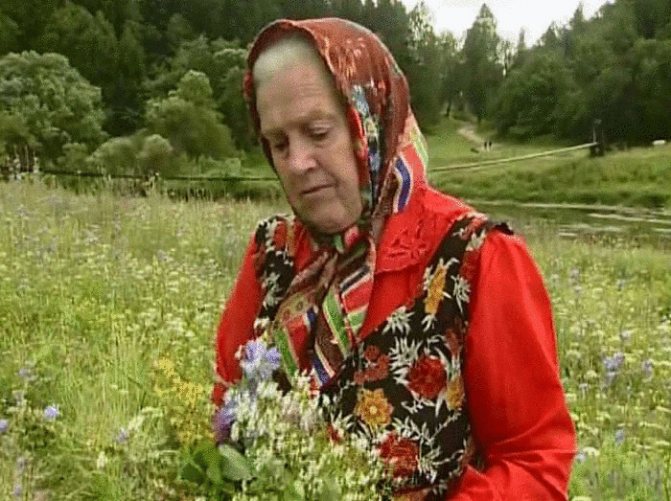

When collecting, they are guided by the general rules:
- raw materials are collected in clear dry weather;
- the collection is carried out in the afternoon, when the leaves have dried from dew - wet plants dry slowly, lose their natural color;
- use a clean, dry, odorless container;
- you cannot collect different types of plants in one container;
- collection is prohibited in cities, near highways, factories, factories;
- it is not allowed to uproot the plant - this clogs the raw materials and does not allow the thickets to recover;
- you can not cut at the root;
- you cannot cut out all the plants;
- re-collection is desirable in a year.
Read also: Planting depth of crocuses in autumn
After collecting, you need to sort and sort the raw materials, removing rotten and dead parts.
Drying
You need to dry the raw material immediately after collection. If the stems are dried outside, they must be placed under a canopy. It will protect raw materials from rain and sunlight, which are harmful to glycosides and vitamins.
The raw material will dry out successfully in an attic with an iron roof, where temperatures can reach 50 ° C in hot weather. In this case, drying takes place quickly, most of the active ingredients, natural color and odor are retained. But any closed, well-ventilated room will do.
You can arrange several tiers of gauze, hanging them at a distance of 30-50 centimeters from each other. This saves space and provides adequate ventilation.
The stems can be tied in thin bunches (which are preferably suspended in a draft) or spread out in a thin layer (1-2 centimeters) on a clean bedding. In the second case, the raw material must be turned over from time to time in order to prevent damage, and make sure that the leaves are straightened, without creases, breaks, twists.
If the weather is cold or humid, the raw materials are dried artificially - in an oven or dryer at a temperature of 50-60 ° C.
Well-dried grass should rub easily with your fingers. After drying, it can be crushed in a mortar, and then the resulting powder can be taken by mixing with water, milk or honey.
Name
Motherwort heart (in latin Leonurus cardiaca) is one of the species of the genus "Motherwort" of the family "Lamiaceae". The term cardiaca comes from the use of a culture for heart disease.
Alternative names
Motherwort is also called common dog nettle, heartwort, heart gold, heart grass. Due to the fact that the arrangement of its upper leaves resembles the tassel of a lion's tail, the culture is also called lion's tail.
Pharmacological properties of this plant


- restores heart rate;
- has a diuretic effect;
- promotes an increase in heart rate;
- normalizes the work of the heart and its system;
- lowers blood pressure;
- relieves spasm of blood vessels;
- normalizes the work of the genitourinary organs;
- helps to restore a regular menstrual cycle;
- improves digestion;
- acts as a sleeping pill;
- acts as an anesthetic.
Due to the fact that the above plant contains phytoncides, experts pay attention to its antimicrobial effect.
How does he look externally
Can be quite high. And even very high. From unsightly thirty centimeters to an impressive two meters! The root of the motherwort is pivotal. The stem is straight, tetrahedral, may have ramifications. Leaves are petiolar. The largest are located at the bottom of the stem, and "on the way" to the top, they gradually decrease.
Motherwort flowers are very small, collected in inflorescences like spikelets. They are located at the ends of the stem, as well as in the leaf axils. The flower cups are divided into several teeth. Each flower has several stamens. The flowering period is from June to September. Flowers grow from the upper leaf axils.


Motherwort fruit consists of several uniform single-seeded lobes resembling nuts. One such slice is not more than three centimeters, enclosed in its own cup. Motherwort fruits cling to animal hair and thus spread throughout the territory.
Gallery: motherwort (25 photos)
Growing motherwort at home
For sowing medicinal herbs in containers, you need to remember that this method requires systematicity and accuracy. Only by adhering to this alignment, the terrace can become a garden. Planting motherwort at home involves stratified seeds and loose soil in a deep container. After disembarking, place the container in a spacious place away from the wall. The containers must have holes, or the plant will quickly die from a lack of permeable oxygen through the soil. Perennial plants require protection during the winter, so the containers should be taken out to a cool but wind-protected area.
Remember! Grasses prefer sunny verandas, balconies and require intensive fertilization twice a week.
Growth features
Both species grow around abandoned ruins. Hearty motherwort grows absent-mindedly, on wastelands, fallow lands. Five-dangerous grows in groups among overgrown bushes, on forest edges, forest belts, meadows.
Note! Both species are successfully cultivated in Russia. Since the bush is perennial, they try to grow it for 3-4 years in one place. They are planted on personal plots and in farms that specialize in the cultivation of medicinal plants.
They thrive on nitrogenous, sandy-clayey soils due to the branched roots. Plants are resistant to drying out of the soil, not demanding on its composition.
What is a plant
Like all other plants, it got its name for a reason. This is due to the place of growth - deserted places or wastelands, where nothing and no one interferes with active growth. The species belongs to heliophiles, that is, it shows a love of sunlight. In shaded areas hidden by trees or houses, it is almost impossible to find a plant.
Initially, the plant in Latin was called "leonorus", which means "lion's tail". This is more due to the appearance of the motherwort, which in structure resembles the tail of a wild animal due to the fact that the inflorescences located along the top of the stem give it fluffiness.
The flowering period of the medicinal plant is in July. Its flowers have a pink or purple tint, are located close to each other, starting to grow from the middle of the stem. Motherwort begins to bear fruit around August. Its seeds look like small nuts hidden at the base of the inflorescences, which, when dried, are thorny cups.
It grows more than 2 m, representing a branched plant with sprouts extending to the sides, which are thin along the entire length and have a lush branching at the end. Motherwort is a perennial. Every year he populates new areas of the soil. Many summer residents perceive the flower with dissatisfaction, since it is considered to be a weed. However, those who know the medicinal features of the lion's tail take care of it and use it in the treatment of diseases of the heart and blood vessels.
How does it multiply
All species of motherwort reproduce by seeds. To improve germination, they are stratified for 60 days. A simplified option is winter sowing.
You can also sow seeds for seedlings first, and then send the sprouted bushes into open ground to a permanent place. The landing pattern is 40 × 40 cm.
All types of motherwort reproduce by seeds.
Important! The ascended seedlings are thinned out so that 4-6 bushes are located on 1 m of the row.
Motherwort care and harvest
Seed crops of motherwort under favorable weather conditions of 2–4 ° C germinate in a week. Care begins with two-year seeding. In early spring, the plant is fed with a nitrogen-phosphorus composition of fertilizers. During the season, weeding and loosening of row spacings is necessary. The yield of motherwort increases over the years.
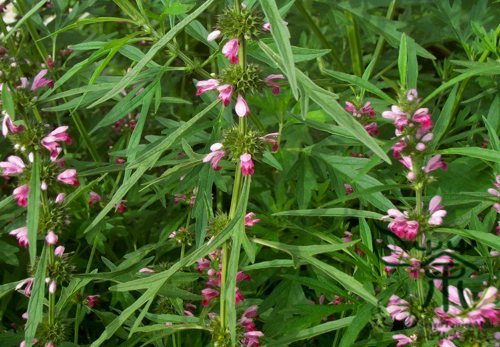

Blooming motherwort
Harvested at the end of July and involves cutting the upper stems and cuttings. In our area, seeds are harvested from the second year with mass ripening of fruits.


